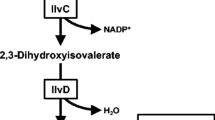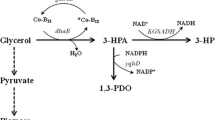Abstract
Escherichia coli MG1655 (DE3) with the ability to synthesize butanol from glycerol was constructed by metabolic engineering. The genes thil, adhe2, bcs operon (crt, bcd, etfB, etfA, and hbd) were cloned into the plasmid vectors, pETDuet-1 and pACYCDuet-1, then the two resulting plasmids, pACYC-thl-bcs and pET-adhe2, were transferred to E. coli, and the recombinant strain was able to synthesize up to 18.5 mg/L butanol on a glycerol-containing medium. After the glycerol transport protein gene GlpF was expressed, the butanol production was improved to 22.7 mg/L. The competing pathway of byproducts, such as ethanol, succinate, and lactate, was subsequently deleted to improve the 1-butanol production to 97.9 mg/L. Moreover, a NADH regeneration system was introduced into the E. coli, and finally a 154.0 mg/L butanol titer was achieved in a laboratory-scale shake-flask experiment.





Similar content being viewed by others
References
Atsumi S, Cann AF, Connor MR, Shen CR, Smith KM, Brynildsen MP, Chou KJ, Hanai T, Liao JC (2008) Metabolic engineering of Escherichia coli for 1-butanol production. Metab Eng 10:305–311
Berezina O, Zakharova N, Brandt A, Yarotsky S, Schwarz W, Zverlov V (2010) Reconstructing the clostridial n-butanol metabolic pathway in Lactobacillus brevis. Appl Microbiol Biotechnol 87:635–646
Berríos-Rivera SJ, Bennett GN, San KY (2002) Metabolic engineering of Escherichia coli: increase of NADH availability by overexpressing an NAD+-dependent formate dehydrogenase. Metab Eng 4:217–229
Biebl H (2001) Fermentation of glycerol by Clostridium pasteurianum-batch and continuous culture studies. J Ind Microbiol Biotechnol 27:18–26
Bond-Watts BB, Bellerose RJ, Michelle C, Chang Y (2011) Enzyme mechanism as a kinetic control element for designing synthetic biofuels pathways. Nat Chem Biol 7:222–227
Datsenko KA, Wanner BL (2000) One-step inactivation of chromosomal genes in Escherichia coli K-12 using PCR products. Proc Natl Acad Sci USA 97:6640–6645
de Graef MR, Alexeeva S, Snoep JL, de Mattos MJT (1999) The steady-state internal redox state (NADH/NAD+) reflects the external redox state and is correlated with catabolic adaptation in Escherichia coli. J Bacteriol 181:2351–2357
Gonzalez R, Murarka A, Dharmadi Y, Yazdani SS (2008) A new model for the anaerobic fermentation of glycerol in enteric bacteria: trunk and auxiliary pathways in Escherichia coli. Metab Eng 10:234–245
Gonzalez R, Blankschien M, Clomburg J (2010) Metabolic engineering of Escherichia coli for the production of succinate from glycerol. Metab Eng 12:409–419
Harris LM, Desai RP, Welker NE, Papoutsaki ET (2000) Characterization of recombinant strains of the Clostridium acetobutylicum butyrate kinase inactivation mutant: need for new phenomenological models for solventogenesis and butanol inhibition. Biotechnol Bioeng 67:1–11
Herrmann G, Jayamani E, Mai G, Buckel W (2008) Energy conservation via electron-transferring flavoprotein in anaerobic bacteria. J Bacteriol 190:784–791
Ingram SW, Stratemann SA, Barnes LD (1999) Schizosaccharomyces pombe Aps1, a diadenosine 5′, 5′ ″-P1, P6-hexaphosphate hydrolase that is a member of the Nudix (MutT) family of hydrolases: cloning of the gene and characterization of the purified enzyme. Biochemistry 38:3649–3655
Inui M, Suda M, Kimura S, Yasuda K, Suzuki H, Toda H, Yamamoto S, Okino S, Suzuki N, Yukawa H (2008) Expression of Clostridium acetobutylicum butanol synthetic genes in Escherichia coli. Appl Microbiol Biotechnol 77:1305–1316
Jones DT, Woods DR (1986) Acetone-butanol fermentation revisited. Microbiol Rev 50:484–524
Klaus B, Heller ECC, Lin T, Wilson H (1980) Substrate specificity and transport properties of the glycerol facilitator of Escherichia coli. J Bacteriol 144:274–278
Li F, Hinderberger J, Seedorf H, Zhang J, Buckel W, Thauer RK (2008) Coupled ferredoxin and crotonyl Coenzyme A (CoA) reduction with NADH catalyzed by the butyryl-CoA dehydrogenase/Etf complex from Clostridium kluyveri. J Bacteriol 190:843–850
Nielsen DR, Leonard E, Yoon S-H, Tseng H-C, Yuan C, Prather KLJ (2009) Engineering alternative butanol production platforms in heterologous bacteria. Metab Eng 11:262–273
Sanchez AM, Bennett GN, San KY (2005) Effect of different levels of NADH availability on metabolic fluxes of Escherichia coli chemostat cultures in defined medium. J Biotechnol 117:395–405
Shen CR, Lan EI, Dekishima Y, Baez A, Cho KM, Liao JC (2011) Driving forces enable high-titer anaerobic 1-butanol synthesis in Escherichia coli. Appl Environ Microbiol 77:2905–2915
Steen EJ, Chan R, Prasad N, Myers S, Petzold CJ, Redding A, Ouellet M, Keasling JD (2008) Metabolic engineering of Saccharomyces cerevisiae for the production of n-butanol. Microb Cell Fact 7:36
Taconi KA, Venkataramanan KP, Johnson DT (2009) Growth and solvent production by Clostridium pasteurianum ATCC 6013™ utilizing biodiesel-derived crude glycerol as the sole carbon source. AIChE Environ Prog Sustain Energ 28(1):100–110
Yazdani SS, Gonzalez R (2008) Engineering Escherichia coli for the efficient conversion of glycerol to ethanol and co-products. Metab Eng 10(6):340–351
Zhang H, Gao A, Li F, Zhang G, Ho HI, Liao W (2009) Mechanism of action of tetrandrine, a natural inhibitor of Candida albicans drug efflux pumps. Yakugaku Zasshi 129:623–630
Acknowledgment
This work was supported by Open Funding Project of the State Key Laboratory of Bioreactor Engineering, P. R. China.
Author information
Authors and Affiliations
Corresponding author
Rights and permissions
About this article
Cite this article
Zhou, P., Zhang, Y., Wang, P. et al. Butanol production from glycerol by recombinant Escherichia coli . Ann Microbiol 64, 219–227 (2014). https://doi.org/10.1007/s13213-013-0654-5
Received:
Accepted:
Published:
Issue Date:
DOI: https://doi.org/10.1007/s13213-013-0654-5




